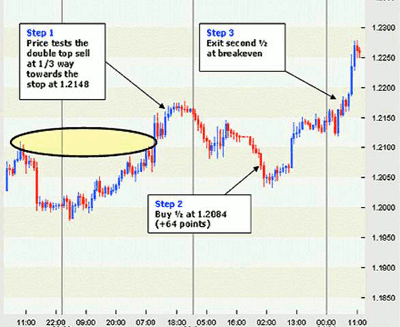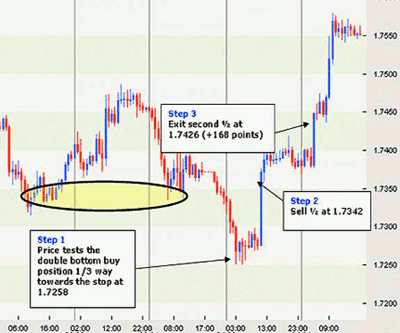The classic memory-of-price set-up is designed to capitalize on spike moves in a currency by carefully scaling into the trade in anticipation of a reversal.
The memory-of-price set-up rests on the assumption that support and resistance points of double tops and double bottoms exert an influence on price action even after they are broken. In effect, they act almost like magnetic fields attracting price action back to those points after the majority of the stops have been cleared.
The thesis behind this set-up is that it takes an enormous amount of buying power to exceed the value of the prior range of the double-top breakout, and vice versa for the double-bottom breakdown.
In the case of a double top, for example, breaking above a previous top requires that buyers not only expend capital and power to overcome the topside resistance, but also retain enough additional momentum to fuel the rally further. By that time, much of the momentum has been expended on the challenge to the double top, and it is unlikely that we will see a move of the same amplitude as the one that created the first top.
One of the concerns some traders have with the memory-of-price strategy is its asymmetrical risk-reward nature. Under the best of circumstance, the set-up harvests one unit of reward for every 1.5 units of risk.
The memory of price works because it is typically a high probability set-up. Indeed, it would have to be accurate 70% of the time in order to have positive expectancy in the long run.
However, traders who are uncomfortable with the negative risk-reward ratios may consider a variation on the theme. This version of the strategy does not offer as many opportunities for trades, and may be less accurate, but its risk-reward ratios are more in sync with conventional trading, and it follows only a single price entry rule rather than a scale-in approach.
Here are the rules of the strategy, long and short:
Rules for the Long Trade
- On the daily or the hourly charts, note a retrace of a down move.
- Measure the amplitude of the retrace, which should be at least 38.2% of the original move.
- Add the value of the amplitude to the swing low, and make that your ultimate stop.
- Enter long the full position (two units) when price falls one-third of the way below the swing low.
- Target 50% of the retrace segment as your profit No.1 (i.e., if retrace segment is 100 points, target 50 point as your profit No.1).
- Move the stop to breakeven.
- Target 100% of the retrace segment as your profit No.2 (i.e., if retrace segment is 100 points, target 100 points as your profit No.2).
Rules for the Short Trade
- 1.On the daily or the hourly charts, note a retrace of an up move.
- Measure the amplitude of the retrace, which should be at least 38.2% of the original move.
- Add the value of the amplitude to the swing high, and make that your ultimate stop.
- Enter short the position (two units) when price rises one-third of the way above the swing high.
- Target 50% of the retrace segment as your profit No.1 (i.e. if retrace segment is 100 points, target 50 point as your profit No.1).
- Move the stop to breakeven.
- Target 100% of the retrace segment as your profit No.2 (i.e. if retrace segment is 100 points, target 100 points as your profit No.2).
The advantage of this strategy is that it has a slightly positive risk-reward skew of about 1.15:1. To fully understand why, simply use a 100-point segment to calculate the ratios.
A trader with a 100-point stop above the swing high would enter at about 33 points above this high, or approximately one-third of the way up. Traders who like Fibonacci numbers may prefer to enter at 38.2% above the swing high, but for matters of simplicity we chose one-third as target entry.
That means that the risk on a 100-point segment is approximately 134 points ((100-33) x 2 units). The reward on this strategy is about 150 points. Target No.1 is 50 points, and target No.2 is 100 points. 150/134 is approximately a 1.15:1 risk-reward ratio, which means that even at 50% accuracy, this set-up has a positive expectancy.
|pagebreak|The Strategy at Work
Now let’s take a look at how this set-up works under price conditions of a fictional currency:
Here we see a retrace segment in the currency that extends from 1.2105 to 1.1979, or 126 points. As the pair breaks to the upside, we short one-third of the way through at 1.2148 at 10 a.m.
The trade moves slightly against us, but then starts its turn, and at 1 a.m. on April 3, 2006, it reaches our first target of 1.2084. We move our stop to breakeven as soon as the first target is hit, and then stay in the trade.
In this case, the trade reaches our first target, but stops us out at the breakeven point on the second half of the position, which is in line with our strategy of never letting a winner turn into a loser.
Finally, here is an example of a long trade using the same idea. Here, we see a strong countertrend segment in the currency that runs for 169 points from 1.7314 to 1.7482.
We enter a buy order at 1.7258, one-third of the way down, with our stop resting at 1.7314 minus 169 points, or 1.7145.
The trade barely moves against us after we enter in our long position, and we then watch as the price continues to rally, letting us take profit on the first half of our position—at 1.7342 on April 3, 2006—and then take profit on the rest of the position at 1.7426, for a total gain of 252 points.
The Bottom Line
The memory-of-price strategy works well for traders who don’t like to take frequent stops, and prefer to bank small profits along the way.
Because losses with a traditional memory-of-price strategy can be substantial when the strategy does miss, this variation has a risk-reward ratio that more traders are likely to find acceptable. At the same time, it may be less accurate that the classic memory-of-price strategy.
Boris Schlossberg can be found at BK Forex Advisors.






















